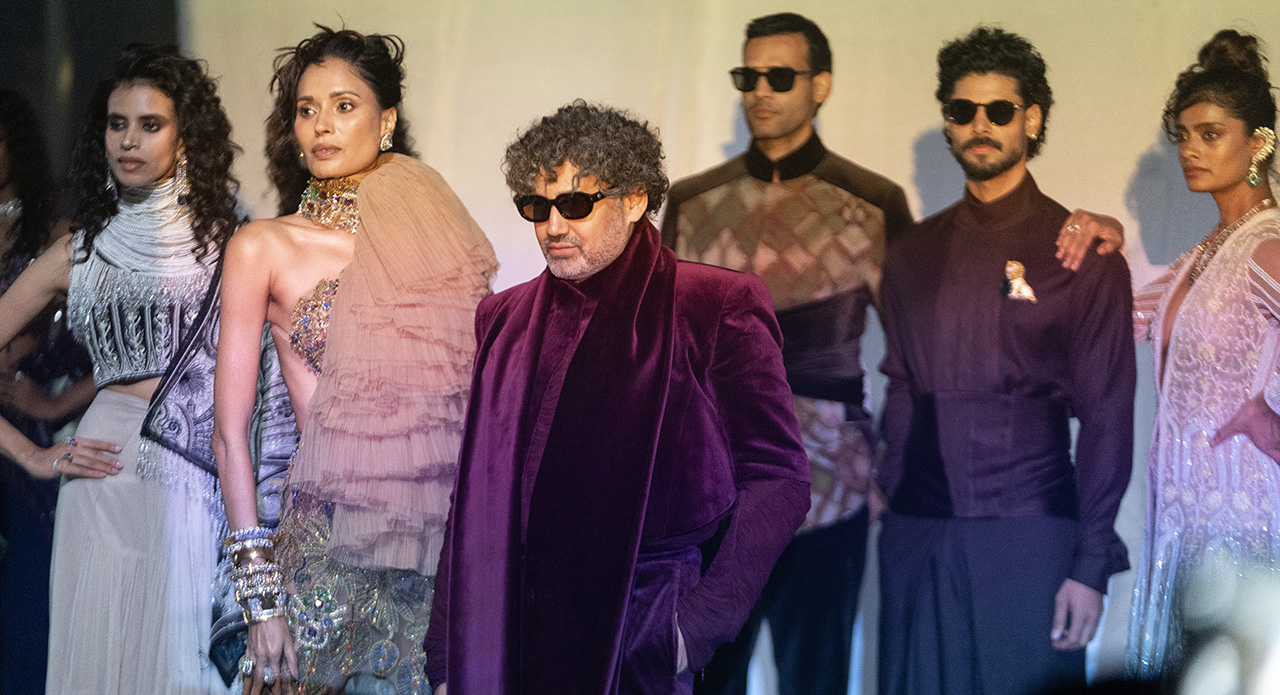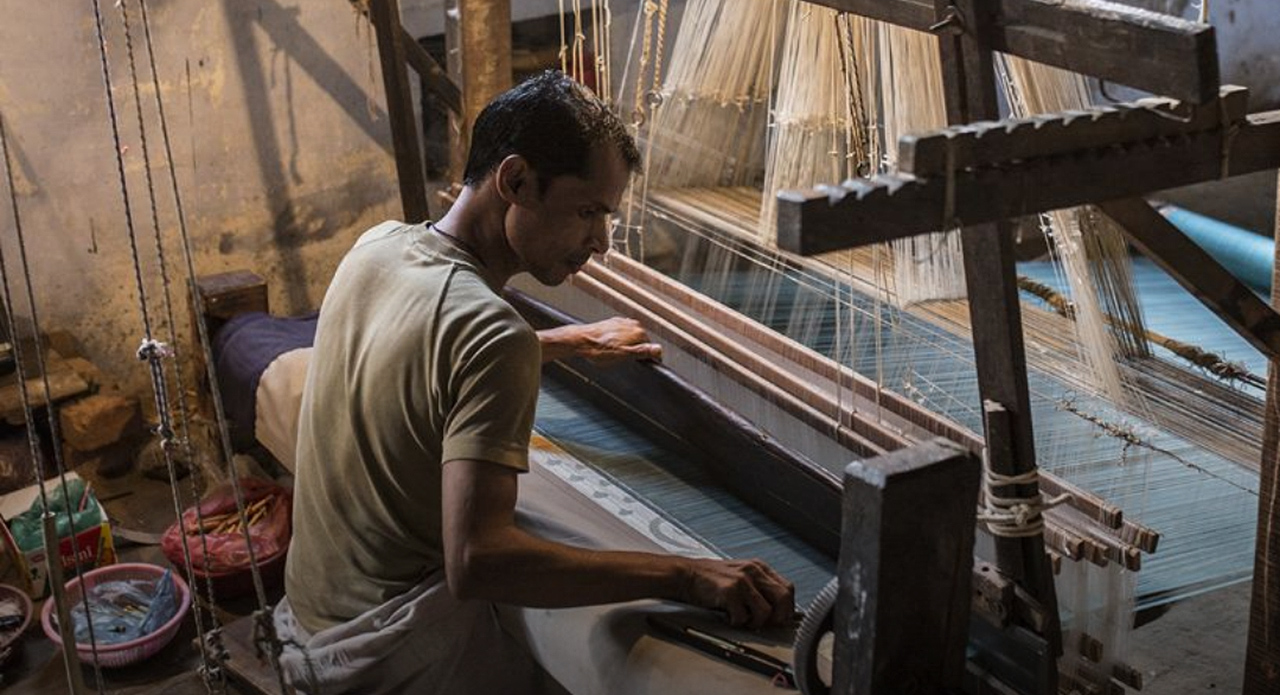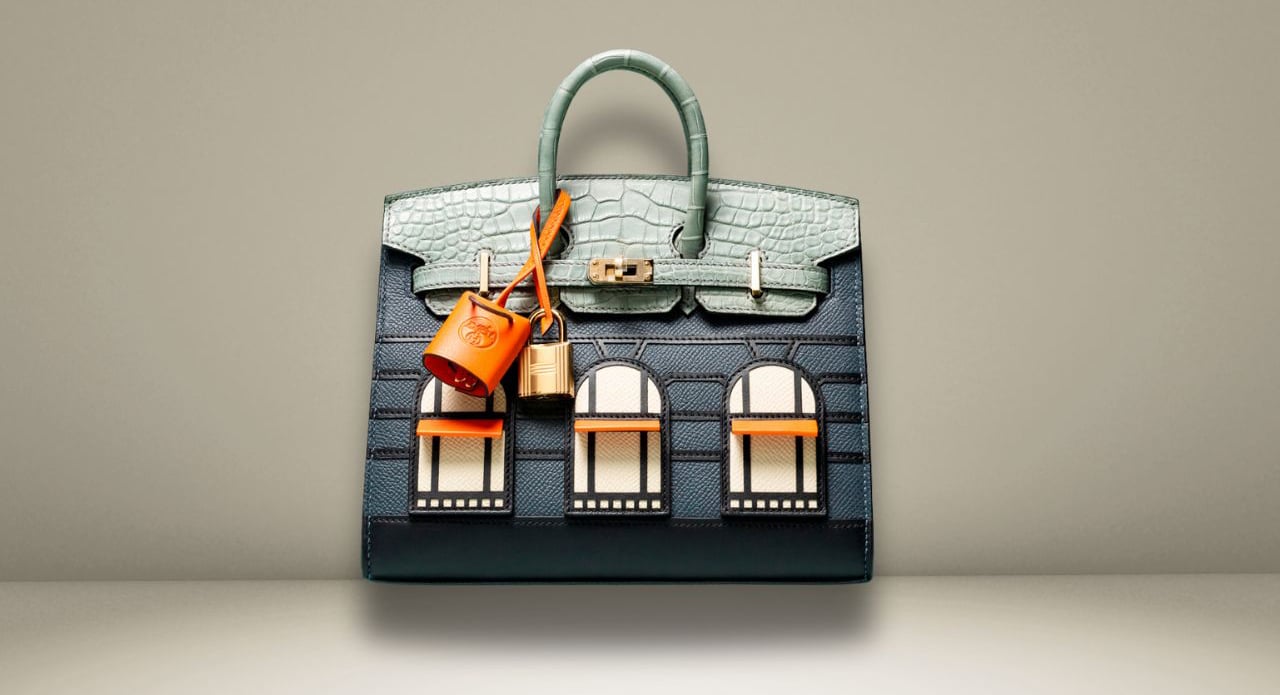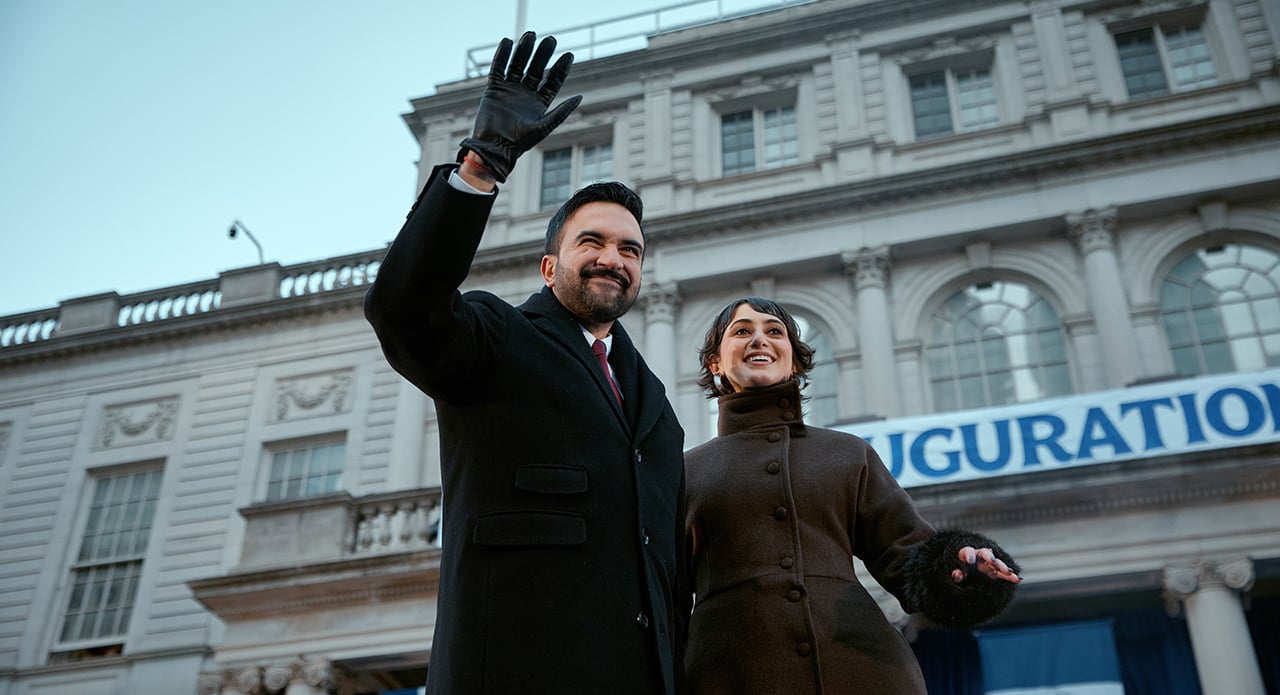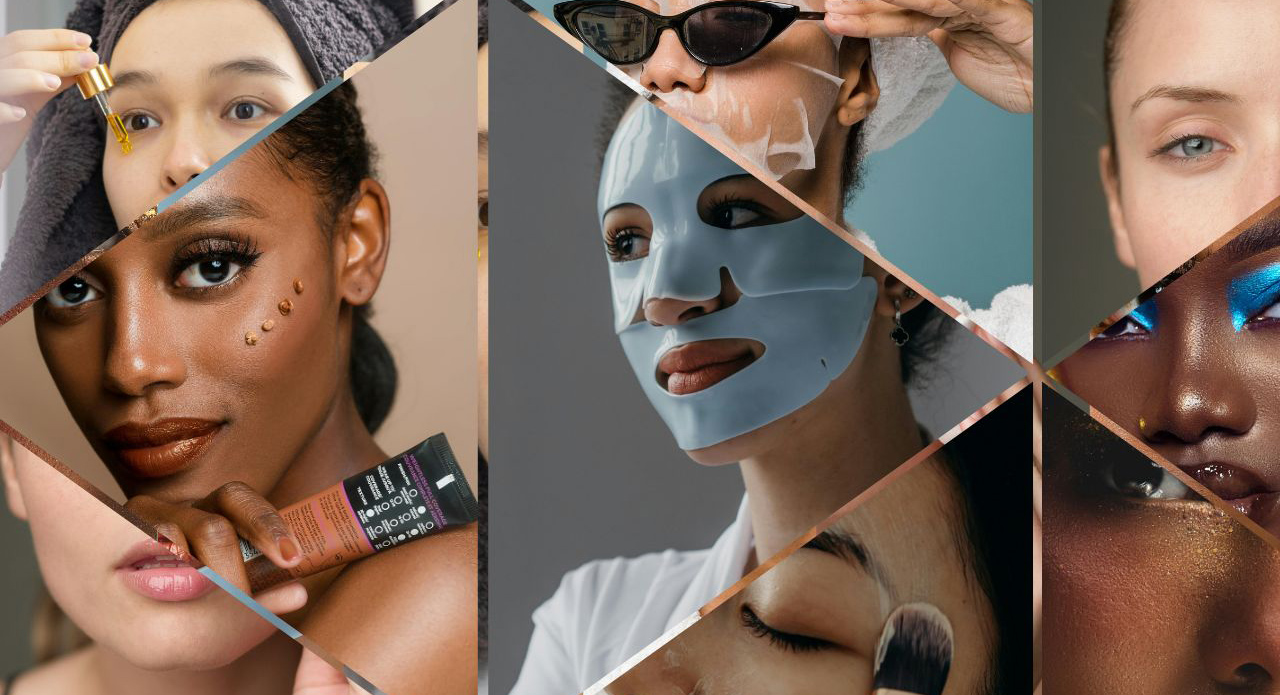In the ever-evolving world of fashion, where sustainability and authenticity are increasingly paramount, Indian handlooms are experiencing a renaissance, with several designers striving to breathe new life into our dying textile traditions. Some passionate designers are revitalising these cherished traditions, reaching into remote corners of rural India, and inspiring artisans to revive their handlooms, moving away from power looms.
From the opulent Chanderi and understated Khadi to the vibrant Ikat and Banarasi, these designers are not only preserving the cultural legacy of handlooms but also redefining their relevance in today’s fashion landscape.
We speak to four fashion designers who are championing Indian handlooms by working with rural India to understand the significance of National Handloom Day and what we can do to revive our rich textile heritage and add them to our modern wardrobe.
ANAVILA MISRA, CREATIVE DIRECTOR AND FOUNDER, ANAVILA
1. How do you give handlooms a young and contemporary image suitable for younger fashion consumers?
At Anavila, we infuse a fresh and youthful perspective to handloom fashion. Traditionally seen as a mature and classic choice due to their rich history, handlooms are now being reimagined with modern aesthetics to appeal to younger generations. By experimenting with minimalistic and contemporary designs, we highlight the inherent versatility of handlooms that transcends age and time. We also engage younger audiences through social media, showcasing handlooms in trendy and relatable ways, and sharing the unique stories behind each piece to create a deeper emotional connection.

2. Name five qualities of handlooms that make them truly luxurious.
Handlooms are crafted from natural fibres which lends a unique texture and quality. The use of cotton, silk, wool, and linen in handlooms gives them an unmatched richness and feel, making them luxurious to touch and wear. Handlooms are also environmentally friendly for eco-conscious people as handloom weaving consumes less energy than power looms and minimises carbon footprint, making it a greener choice. They can comfortably be worn in various climates, providing breathability, as they are soft on the skin and allow for better air circulation, making them perfect for hot and humid climates. Each handloom piece is a one-of-a-kind creation, showcasing the weaver’s skill and creativity. The intricate patterns and designs are often inspired by local traditions and cultural motifs, making each garment a unique piece of art. It’s important to understand that the time and effort invested in each piece make handloom garments special and treasured, often passed down through generations as heirlooms.

Read Also – India’s Textile Traditions: A Modern Renaissance
3. How can fashion lovers make handloom a conscious choice for everyday dressing and not just as occasion-wear?
If you haven’t started your handloom journey yet, start with handloom saris or kurtas and gradually introduce unique pieces like handwoven scarves or jackets to maximise the utility of these wardrobe staples. Depending on what your wardrobe choices are, you can easily find handloom-based options to add to your everyday wardrobe.
- Try mixing handlooms with modern apparel to create a wardrobe that is full of cultural heritage and is also environmentally sustainable.
- Colours and materials play a significant role in defining whether a piece is for daily wear or special occasions. For example, you can wear a kora cotton kurta from any handloom cluster as an everyday option. For a more statement-making or celebratory occasion, you can opt for a bright coloured heavy silk and zari sari woven in handloom.
- A handloom kurta can be paired with jeans for a casual look or a skirt for a more formal appearance. Handloom dupattas can be used to add a touch of elegance to any outfit.
- By mixing and matching handloom pieces with contemporary clothing, fashion lovers can create stylish and unique ensembles that stand out. Stores like Good Earth, Ogaan, Amethyst, Ensemble and many more offer a wide array of handloom garments suitable for daily wear as well as special occasions.
Anavila Misra’s Must-Have Indian Handlooms
1. Jamdani: Known for intricate and delicate patterns, perfect for elegant attire.
2. Ikat: Popular for bold and vibrant patterns achieved through a unique dyeing technique, suitable for casual and formal wear.
3. Khadi: Luxurious in its simplicity and versatile for creating a range of garments from casual kurtas to formal suits.

4. Suggest three things that can be done to revive Indian handlooms.
I believe that brands and designers should maintain transparency in their work with the craft sector, ensuring fair practices. By providing clear information about the sourcing of materials and the production process, brands can build trust with consumers and promote ethical consumption. Secondly, sharing real stories behind each handloom piece can foster a deeper connection with consumers. Highlighting the weavers’ craftsmanship, their cultural heritage, and the time and effort invested in each piece can create an emotional bond between the product and the consumer. However, to grow and sustain these crafts it is important to provide fair wages and sustainable employment opportunities for weavers. By ensuring that artisans are paid fairly and have stable working conditions, we can encourage more people to continue the tradition of handloom weaving.

5. What are your thoughts on National Handloom Day and elaborate on your initiatives to resurrect handloom in India?
National Handloom Day is a wonderful initiative that celebrates India’s diverse and rich handloom heritage. It acts as an annual festival, invigorating the sector with various events and stories. Our initiatives, at Anavila, include long-term interventions and creating sustainable employment in all our clusters. By providing training and skill development programs, we empower weavers to improve their craftsmanship and adapt to changing market demands. Other than that, we are committed to sharing the stories of our weavers, and raising awareness about the craftsmanship and effort involved in creating each piece. Through social media campaigns, exhibitions, and collaborations with influencers, we aim to highlight the beauty and significance of handlooms.
For young designers working with handloom, I suggest they stay true to their design philosophy, and incorporate their unique perspective to create a distinctive brand. Designers should respect the craftsmanship and efforts of the weavers and build strong relationships with artisans and collaborate closely with them to create better designs and higher-quality products. Last but not the least, build a trust with consumers through transparency. Being open about your sourcing, production practices, and the impact of your work can foster loyalty and support from conscious consumers.
VAISHALI SHADANGULE, DESIGNER AND FOUNDER, VAISHALI S STUDIO
1. Why is it important to innovate and contemporise Indian handlooms?
The wearers and the buyers of our handloom heritage are the younger generation. Eventually both Indian and global, we must make our heritage understandable and wearable for them. Indian handloom products have been long associated with traditional attire, barely used beyond functions like weddings. But at the same time, these traditional textiles are highly sought after by international designers for whom the level of workmanship and beauty, and adherence of slow fashion philosophy dictates the essence of luxury products. Handloom products are versatile and can be styled in various ways. I think it is the designer’s responsibility to make more and more use of them and to teach how to style them. As for me, I am trying not only to give them a modern and global design but also to make my pieces in layers and separate parts of the main look, which can then be used as everyday pieces. It is high time that we Indians also take advantage of our heritage and present it properly, contemporised, but not improperly appropriated.

2. What are some must-have handlooms from India that you love working with for your collections?
Oh, that’s difficult! I love them all and depending on the mood or occasion I prefer using one or the other. They are all so unique and different, that I can’t really say which one I prefer. I have emotional stories with each one of them, on how I discovered it, modified it, or the people that work at it, but that is a different story. For instance, when I started working with Chanderi it was seen almost as an insult to our roots, and I was treated as an outcast. Luckily now it has changed a lot, and as usual, this has come from acknowledgement in international markets.

3. What is the future of Indian handloom and what suggest a few corrective measures can we do to revive its lost glory?
Indian handloom has a great future. As I said, the luxury world is already using them, without declaring it. The world has understood that handloom textiles are the real couture due to their workmanship, skills, detailing, lasting quality, etc. Unfortunately, handloom has a negative perception in India, such as poor and lesser quality. This is probably because their quality and finishing have been overlooked. For Handloom to become mainstream, we need due recognition and better treatment as a luxury product. The movement is picking up in India—once we realise that handloom is luxury, and not only are bare silk fabrics overloaded with textures, but it will also become a huge wave.

4. Your thoughts on National Handloom Day and tell us about your initiatives to promote handloom in India
National Handloom Day has made a big impact on the recognition of handloom fabrics, and it has been the igniting force of the movement. The Government is making efforts, especially around this Day to promote and sensitise people about handlooms. Now designers must start moving, sincerely.

5. How would you recommend young designers working with handloom to make a difference with their labels?
Learn how to hand weave. Unless you understand the techniques and how the fabric would fall in one technique or the other, it will be difficult to make real use of them and create outstanding outfits.
GAURAV KHANIJO, DESIGNER AND FOUNDER, KHANIJO
1. How do you give handlooms a young and contemporary image to become a part of a wider fashion consciousness?
By blending the rich heritage of handlooms with modern trends and sustainability, it’s possible to create a fashion narrative that resonates with younger audiences while preserving the traditional essence of the craft. It is essential to change the perception of handloom textiles through education, innovative design, strategic marketing, and making handloom products more accessible and affordable. Highlighting their uniqueness, sustainability, and cultural value can also help in integrating handlooms into mainstream fashion conversations and wardrobes.

2. How can the modern Indian man embrace Indian handloom with its rich colours, weaves and crafts?
By integrating handloom fabrics into various aspects of their wardrobe, modern Indian men can embrace and celebrate the rich heritage of Indian handlooms while staying stylish and contemporary.
- Handloom fabrics, being breathable and comfortable, are perfect for summer wear. Consider handloom shorts, shirts, and kurta-pajamas for a relaxed, stylish summer look.
- Embrace handloom fabrics for traditional attire such as sherwanis, kurtas, and dhotis. Handloom fabrics can add richness and authenticity to festive and cultural events.
- Introduce handloom fabrics into office wear. Handloom shirts and blazers can be stylish and professional, while also showcasing craftsmanship and supporting local artisans.
- Mix and match traditional handloom pieces with contemporary fashion. For example, pairing a handloom jacket with a modern shirt and trousers, or a handloom kurta with denim jeans.
- Use handloom stoles, shawls, and jackets for layering. This not only adds texture and depth to an outfit but also provides a versatile way to incorporate handlooms into different looks.

3. How can handlooms be made more accessible to become a conscious choice for everyday dressing?
Reviving these textiles and others requires a commitment to preserving their essence while adapting to contemporary tastes and market demands. By doing so, we can ensure that these beautiful crafts continue to thrive and remain an integral part of our fashion landscape. My favourites are Ikat, Ajrakh, Chikankari and traditional forms of quilting. We need to encourage designers and brands to create versatile handloom collections that cater to everyday wear. Modern silhouettes, comfortable cuts, and functional designs can make handlooms appealing for casual and workwear. Highlight the sustainability and ethical aspects of handloom production. Educate consumers about the environmental benefits of choosing handlooms over synthetic, mass-produced fabrics.

Gaurav Khanijo’s Must Have Handloom Textiles For The Modern Man
1. Khadi: Known as the fabric of freedom, Khadi is a versatile, hand-spun, and hand-woven fabric. It is comfortable, breathable, and perfect for both casual and formal wear.
2. Ikat: This fabric is known for its unique dyeing technique, resulting in vibrant, geometric patterns. Ikat shirts, jackets, and accessories like ties and pocket squares add a stylish, contemporary touch to any outfit.
3. Linen: Handloom linen is breathable and perfect for hot weather. Linen shirts, trousers, and blazers can create a polished yet relaxed look, suitable for both casual and professional settings.
4. Bhagalpuri Silk: Known as Tussar silk, Bhagalpuri silk has a natural texture and sheen. It’s ideal for creating elegant kurtas, jackets, and even formal suits.
5. Handloom Cotton: A classic choice for everyday wear, handloom cotton is comfortable and durable. Shirts, trousers, and kurtas made from handloom cotton are versatile and timeless.
6. Banarasi Brocade: While often associated with occasion wear, Banarasi brocade can be used creatively in modern fashion. Jackets, waistcoats, and accessories like stoles can incorporate this rich, intricate fabric for a luxurious touch.
7. Block Printed Fabrics: Fabrics with traditional block prints, such as those from Rajasthan and Gujarat, can add a unique and artistic flair to everyday wear. Shirts, kurtas, and even trousers with block prints can be both fashionable and culturally significant.

4. What are your thoughts on National Handloom Day and your initiatives to empower artisans in India?
We are committed to ethical and sustainable practices. Our textiles are meticulously made and sourced from NGOs and certified Khadi licensed clusters, reflecting our dedication to supporting traditional Indian crafts and sustainable fashion. Additionally, we collaborate with various craftspeople and tribes across India, incorporating their unique skills and heritage into our textiles and products.

5. What would you recommend to young designers working with handloom to create a proud homegrown brand?
They should incorporate traditional handloom techniques with contemporary designs and modern aesthetics. Experiment with new patterns, cuts, and silhouettes that appeal to younger consumers. Develop a unique design signature that sets your label apart. Use distinctive motifs, colour palettes, and innovative techniques that highlight the handloom fabric’s versatility. Collaborate with other designers, artists, and brands to create innovative collections and expand your reach. Educate your consumers about the value and uniqueness of handloom fabrics through your marketing efforts. Highlight the benefits of supporting sustainable and ethical fashion.
SHRUTI SANCHETI, FOUNDER, SHRUTI SANCHETI
1. Why do you think it is important to innovate and contemporise Indian handlooms?
India has an unsurpassed legacy of weaves and textiles, being one of the few countries which has weaving traditions intact. Our weavers possess unparalleled skills and expertise. However, with rapid globalisation and increasing urbanisation, it’s crucial to make these weaves relevant to the new generation. Contemporary motifs, improved thread counts, and current colour palettes are essential for making handlooms appealing to Gen Next.

2. You recently showcased at the BRICS+ Fashion Summit in Moscow led by the Fashion Design Council of India; do you think Indian handloom is more in demand internationally than in India?
Globally, handmade and handcrafted items are celebrated, and slow fashion is slowly gaining momentum. In Moscow, khadi was greatly appreciated because of its unique properties of keeping one both cool and warm and also because of its unique character. They fell in love with our woven fabrics and were deeply curious about this luxurious and sustainable fabric.

3. How has the perception and demand for Indian handlooms changed in the last few years?
Handlooms are cherished largely for their diverse weaving traditions, sustainability, and breathability. Every region in India has its own weaving tradition. Although khadi played a pivotal role in the Indian freedom movement, post-Independence saw a shift towards mill-made fabrics. Thanks to the efforts of textile revivalists, the government, and textile aficionados, there is now a renewed interest and appreciation for handlooms, recognising their understated opulence and restrained luxury.
4. What are some must-have handlooms from India that you recommend as part of any Indian wardrobe?
I have a deep appreciation for khadi, not only for its historic significance, but also for its versatility, season-fluid nature, and sustainability. Other favourites include Ikat from Orissa, Patola from Gujarat, Tanchoi from Uttar Pradesh, Mangalagiri cotton and Upada from Andhra Pradesh, Jamdani from Bengal, Muga from Assam, and Madras checks. Our contemporary Khadi layers, Pochampally and Benares trenches, and Karnataka silk pants and shirts are must-haves for any wardrobe.

5. Your thoughts on National Handloom Day and tell us about your initiatives to resurrect handloom in India as a fashion designer
National Handloom Day is a tribute to the Swadeshi movement that started on August 7, 1905. Last year, we pledged to say no to polyester in any form, to reduce our reliance on man-made fabrics, and to engage more with our clusters and weavers. We are committed to using these glorious fabrics for our trade shows and international exhibitions. Recent geopolitical upheavals have taught us to be responsible consumers and to embrace a slow and sustainable lifestyle that includes season-fluid, timeless, and versatile fashion. My recommendation to younger designers’ keen on working with handlooms is that while you may not be able to change these age-old traditions, you can approach them differently. The fashion and textile industry must collectively contribute and collaborate to create futuristic woven fabrics that are both aesthetic and engaging. Business houses should patronise these clusters and artisans, and the government needs to provide impetus and schemes to encourage and promote indigenous weaves.




